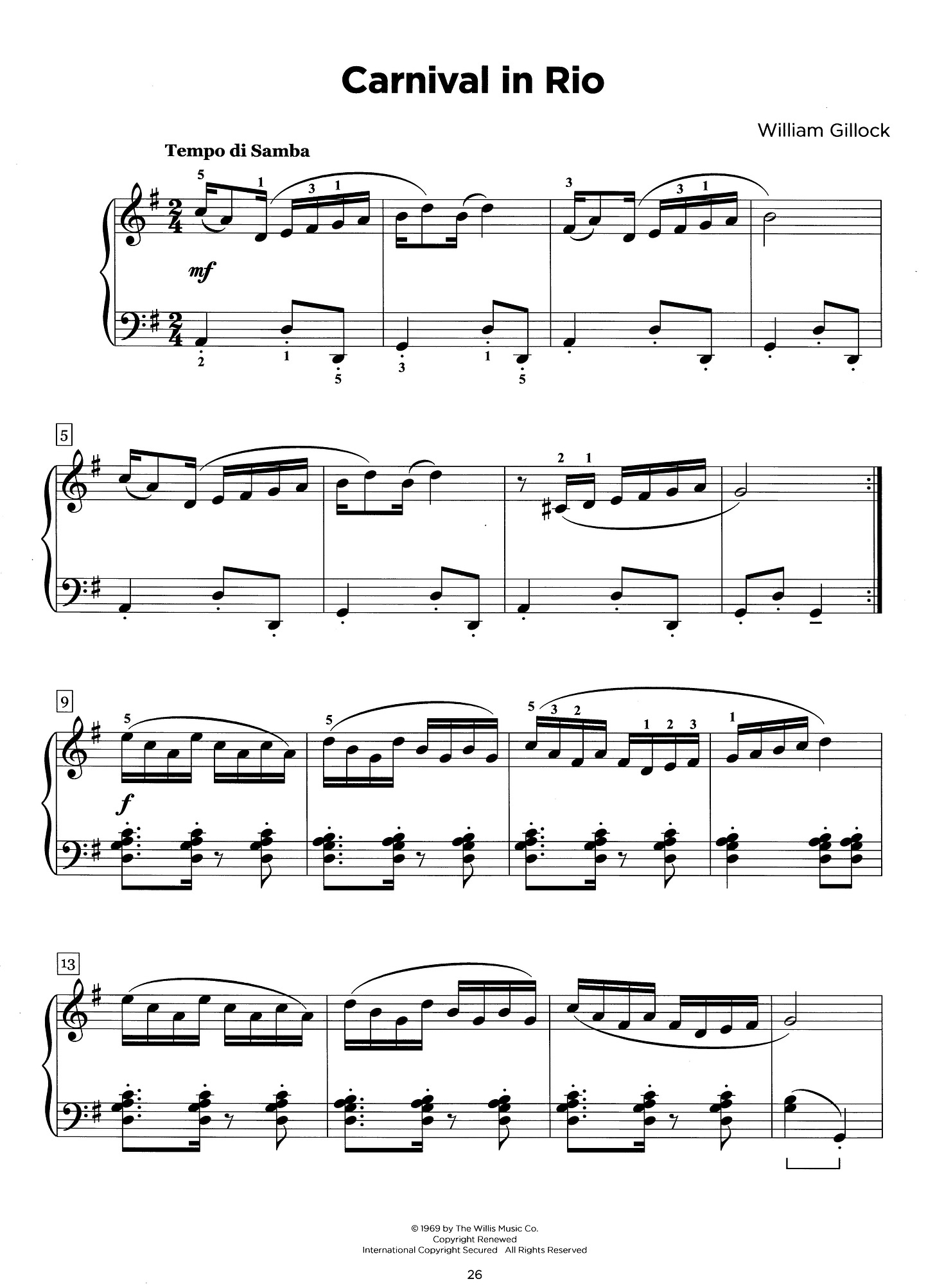Improvising, "Carnival in Rio" style
Julian Lambert's free backing track for William Gillock's wonderful piece is a great opportunity to get creative with simplified Latin rhythms
William Gillock’s “Carnival in Rio” is a wonderful piece and an accessible introduction to a simplified samba style, with easy-to-learn left hand accompaniments.
Inspired by Andrew Eales’ excellent publication The Graded Gillock (Hal Leonard, 2022), Julian Lambert created a backing track for “Carnival in Rio” that you can play along to. It’s currently free to download from his website.
This gives us an excellent opportunity for improvisation!
GETTING STARTED
Here’s Julian Lambert performing the piece with the backing track:
…and here’s a preview of the first page of the Graded Gillock’s edition of “Carnival in Rio”, with kind permission from the publisher.
I’ve got a copy of these books. They’re beautifully put together, clearly edited, and contain an excellent selection of music that can be used as an accessible gateway into many different world styles. Recommended! Find out more here.
TEACHING SCENARIOS
If your student is familiar with improvisation, this is a great piece to explore because the chords are so simple (D7, G/D repeated multiple times). They can use Gillock’s accompaniment patterns in the left hand and improvise in G major in the right. Personally I find it a bit easier to improvise over the second pattern (bars 9-16) than the first (bars 1-8) but their experience may vary.
If your student is new to improvisation, it’s best to get them to improvise just the melody with their right hand. Here are some tips and my method for introducing melodic improvisation to beginners.
INTRODUCING IMPROVISATION TO BEGINNERS
It’s important to present improvisation as not a big deal. In some cases it’s best not to even use the word “improvisation” (which can cause fear) until after they’ve already improvised! I will often say “just move your hands freely on the scale we just used”.
Some students feel uncomfortable when improvising, so keep an eye on their body language, watching out for signs of tension, and be careful not to push them too far out of their comfort zone.
Emphasise that when we create music, there are no such things as wrong: there are simply sounds they like, and sounds they don’t like.
Tell them that the first job of an improviser is to figure out what they like. The second job is to do more of it!
METHOD FOR GETTING BEGINNERS TO IMPROVISE
You can end this activity at any time, you don’t need to work all the way through to step 9.
get them to play the G major scale in time with the recording.
explain that G is the “home note” (tonic) of the scale, so if they want to make a melody that sounds finished, they’ll want to end there
replay the recording and encourage them to practise moving their fingers freely within the G major scale, listening to the music they make
as they play, listen out for interesting motifs (I encourage mine when they’ve done something cool by simply calling out “Yeah!”)
as you get close to the end of the recording, remind them that they’ll want to finish on G, the “home note”
when the recording is finished, play them your favourite of the motifs they came up with (it doesn’t matter if it’s not particularly inspiring, it just needs to be slightly memorable)
explain to them that to improvise coherently they’ll want to play varied repeats of their favourite motifs
show them how they could change their motif:
change the pitch of one or more notes
add an intensifying rhythmic twist by adding a few extra fast notes
add a de-intensifying rhymic twist by removing a few notes or playing it more slowly
repeat the motif higher or lower (i.e. if the first note was a B, move your hand to a new position and start it on an A or a C)
get them to play with the recording again, and encourage them to use and change their motif
FURTHER STUDY
If you enjoy the Samba inspiration of Gillock’s Carnival in Rio and you’re curious to explore some Samba with a Brazilian who really knows that he’s talking about, you’ll love this introduction to the Samba groove by the wonderful Jovino Santos Neto — he explains its complexity in a very clear way and it’s a joy to play!
If you want to turn this piece into a student-teacher duet, with you playing the accompaniment, here’s a little accompaniment pattern that I like to use.
Here’s a recording:
For a much deeper dive, Jovino Santos Neto also gave a much more in-depth lecture at the Berkeley College of Music about the rhythmic language of Brazilian language:




